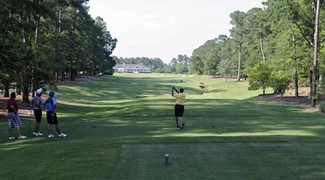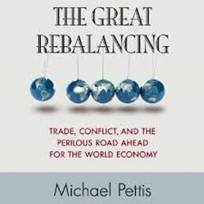 The Carolinas’ Red Neck Riviera is being invaded by Chinese investors. At least 12 Myrtle Beach area golf courses now have Chinese owners.
The Carolinas’ Red Neck Riviera is being invaded by Chinese investors. At least 12 Myrtle Beach area golf courses now have Chinese owners.
This appears to be good news for the region’s economy. Plus, to golfers the changes might seem like a subtle break on a new green; they might not even notice at first.
So, let me be your caddy around this tricky but fascinating economic layout. However, you’ll have to trust my experience and observations – along with lots of numerous unnamed sources who helped me read the grain of all that is happening down here.
I won’t get specific about any golf course. The Sun Times of Myrtle Beach has numerous stories on courses now owned by Chinese investors.
Instead, this post is more like a fly-over version like my drone camera with GPS.
And the view is still great.
 The main reason you won’t see any changes right away is the Chinese business culture. One source told me, “The Chinese don’t move at the pace most Americans expect.”
The main reason you won’t see any changes right away is the Chinese business culture. One source told me, “The Chinese don’t move at the pace most Americans expect.”
Plus, many of them — born Communists/converted capitalists — are just being good salespeople. They’re learning the territory like any newcomer to the area would do. Like any region, Myrtle Beach to Wilmington has quirks and nuances. But imagine the extra cultural education a Chinese owner must absorb.
So, there have been some mishits. For instance, one golf course raised the Chinese flag alongside the US and state flags during a golf tournament for, of all the groups, U.S. war vets. Was it an international incident? No, but there was some grumbling.
This cautious approach has also led to tightened budgets, job cutbacks or reduced responsibilities for local workers. Talk to enough local golf personnel and you will hear some nervousness about job security.
That doesn’t mean the Chinese investors don’t have big plans. There is talk of major hotel resorts that could bring new tourists, especially Asian tourists, to the region. But many of those plans have not been revealed or are still on the drawing boards as these owners navigate local planning and zoning officials. That, in turn, has paused any new hiring.
Still, I don’t hear loud angst from locals. Instead, it’s more like, “We’ll take a wait and see attitude.”
But I also hear: “This is just the tip of the iceberg.”
Many courses, still owned by locals, say they have been approached by Chinese investors. I can’t document this, but some of my sources say probably every course has been at least contacted about selling.
That brings us to why?
It’s simple. The Chinese need to buy – or move assets out of China — and local golf courses, in the assessment of the Chinese, are bargains.
Many golf courses here sit on cheap land after the financial crisis. In addition, many US owners bought before the bust with inflated values and huge debt.
 “When someone comes along and offers to get you out from under it, you jump at it,” one source told me.
“When someone comes along and offers to get you out from under it, you jump at it,” one source told me.
For the Chinese investors, these golf courses are “safe haven assets” compared to China.
Although China’s economy is still hitting GDP numbers like 300-yard drives, their growth is slowing.
But it might be worse in China. Other financial intelligence sources tell me that those 300 yard drives are really only flying about 150 yards. (Talk about handicap inflation!) The Chinese GDP numbers don’t get scrutinized like the GHIN. For instance, some sources tell me that the total of China’s goods and services don’t match the levels of products being moved by Chinese trains.
Is this for real? Who knows?
But remember China has more than 1 billion people. Many of them want more pay so they can live a middle class life. That’s progress. But at the same time, those cheap factory jobs have gone elsewhere to places like Vietnam or back to the US thanks to the shale oil boom.
That means China needs to keep a lot of people happy who don’t have as much work. Chinese culture fears one thing: 1949 when the revolution began.  China has moved a long way from Mao – towards capitalism. But the easterly winds seem to say there has to be a return to more socialistic ways for a population that has gotten into the western capitalistic swing. Posting the exact economic score might not be in the government’s best interest.
China has moved a long way from Mao – towards capitalism. But the easterly winds seem to say there has to be a return to more socialistic ways for a population that has gotten into the western capitalistic swing. Posting the exact economic score might not be in the government’s best interest.
If this is the case, the government will pay more social safety net – while not creating state-owned businesses. In addition, as the Chinese Yuan drops in value, China would love to get their hands on more of the ever-growing, safe-haven dollars which will probably be brought back to China by some of the investors. (To learn more about this change in the Chinese economy, read Michael Pettis’ The Great Rebalancing.)
You also have to assume these Chinese investors have elite status with the ruling Communist Party, so they might know the real numbers and the real economic conditions – which is another reason to get their money out of China.
The biggest reason may be the growing US economy. Read The Accidental Superpower by Peter Zeihan who believes the only economy that will flourish over the next 20 to 30 years is right here in the good old USA.
 And the US government is also helping to get this Chinese money here faster. Many of these investor-owners use an EB-5 visa. With an investment in a US business, along with other stipulations like creating jobs, Chinese residents can get access to US citizenship and work visas for themselves and their families.
And the US government is also helping to get this Chinese money here faster. Many of these investor-owners use an EB-5 visa. With an investment in a US business, along with other stipulations like creating jobs, Chinese residents can get access to US citizenship and work visas for themselves and their families.
This is good news for the region on balance.
The financial crisis dried up lots of capital so golf courses couldn’t expand or improve. This new infusion of capital and risk will only help the region grow economically.
Granted, locals might long for these current days when a round of golf cost as low as $25 including breakfast, lunch, and two beers.
But the future could bring a new landscape of golf development Chinese style. Check out Mission Hills in Shenzhen, China. The Chinese have also developed Hainan Island, known as their Hawaii, with championship golf resorts.
This is part of the golf boom in Asia. Last January, I was hitting golf balls in 33° weather in Seoul, South Korea indoors at one of the ubiquitous driving ranges inside luxury hotels. In some Chinese business schools learning golf is a prerequisite. So much for Communism.
But capitalism has its busts. Look at the 1980s when the Japanese bought US golf courses like Pebble Beach before going broke and selling them back at deep discounts to US owners.
Could the Chinese owners see a similar fate?
Probably not. If anything, the Chinese will continue to prime the pump of their economy. That will force them to continue appearing wealthy while at the same time devaluing their currency. And to find good returns they will need to look at the one economy that will create more golfers — which is right here.
Give me your feedback. Tell me what you’re seeing.
(The John Daly Golf Show is a production of NOWtv and the video episodes can be seen here.)
Comments on this entry are closed.